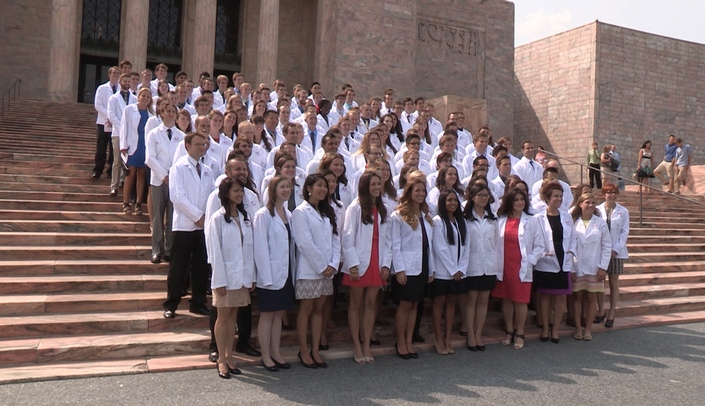As I attended the College of Medicine’s White Coat Ceremony on Aug. 17, I couldn’t help but reflect on how things have changed – for the better – for our medical students.
The White Coat Ceremony was started in 1993 at Columbia University by Dr. Arnold Gold, a pediatric neurologist and faculty member. It has now become an engrained ritual at nearly every medical school in the country and in many foreign countries.
It is a great event that marks the students’ passage from being a lay person into a member of the health care profession. It has become a symbol of professionalism. Students take an oath in which they promise to treat patients to the best of their ability, to preserve the privacy of patients, and to teach the skills of medicine to the next generation.
Just observing the students and their parents it’s easy to see what a prideful moment the White Coat Ceremony has become. The white coats are paid for through the generous donations of our College of Medicine alumni, to whom we are all grateful.
The coats truly have special meaning. They mark a key milestone in the path to becoming a physician. In addition, as a unique UNMC feature to the ceremony, the pockets of each white coat contained a personalized message from one of the student members of the Gold Humanism Society Chapter at UNMC to their new colleagues. My thanks to the students who took the time to create these very special mementos for our incoming students.
Looking back on my days in medical school at the University of Southern California in the late 1970s, it was a much different landscape. There was no white coat ceremony. We went to the bookstore and bought our own white coats, as we needed them the first week of class for the start of our introduction to clinical medicine course.
In addition, all the students were expected to purchase their own leather doctor’s bag – something one seldom sees in today’s world of medicine. By the way, if anyone is in need of a doctor’s bag, I think mine is still around some place.
My strongest recollections of the first year of medical school were that I spent a lot of time studying. Back then, it was all about rote memorization, and the curriculum was much less progressive than it is today. Disease prevention and social determinates of health and wellness were seldom, if ever, discussed. In addition, we were all challenged to learn how to talk to patients, take a history, and write it up and present it to our clinical instructor in a coherent and efficient manner.
Like a number of med students at USC, I lived in dorms on campus for my first two years. The medical school was located across the street from the Los Angeles County Hospital. The medical school bordered a part of town where the crime rate was high. If we left our dorm windows open on the weekends, you could occasionally hear the sound of gunfire. I remember one of my classmates being robbed across the street from campus. In spite of the challenges of medical school, we made it through that first year and the class of 2022 will as well.
As the new school year begins, several special events mark September. We will welcome the new dermatology department faculty on Sept. 11, and on Sept. 12, we will hold the Circle of Distinction event to recognize those faculty with endowed chairs and professorships and the donors who made them possible.
On Sept. 20, we will celebrate the 10-year anniversaries of the Sorrell Center – the home of the College of Medicine – and the Holyoke Society, the honor club for donors who have contributed $100,000 or more to the medical center. We also will recognize Dr. Michael Sorrell, one of the legendary physicians in the history of UNMC.
Finally, I want to applaud all the researchers at UNMC who combined to bring in a record $135.6 million in research funding in the past year. This was a significant gain of 15.8 percent over the previous year’s record of $117 million. College of Medicine funding increased 11.4 percent and accounted for about 64 percent of the overall research funding to UNMC.
Dr. Jennifer Larsen, vice chancellor for research, leads the UNMC research enterprise. She deserves congratulations, as UNMC recorded increases in the total number of grants, the number of unique principal investigators, the total number of faculty on grants, the average size of grants, and the number of large grants such as center grants.
At a time when research funding at the National Institutes of Health has remained relatively static, UNMC has somehow managed to make remarkable strides in procuring research dollars. My congratulations to all whose hard work made this possible. It is a tremendous accomplishment.
